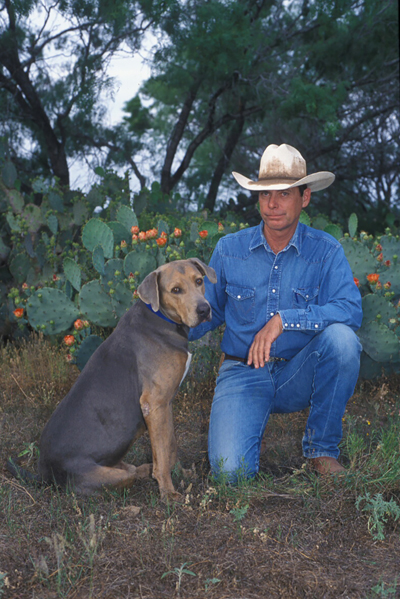
“LITTLE ROY” HINDES IS A SECOND-GENERATION rancher/hunter in South Texas and is known to have some of the best deer tracking dogs in Texas. Pictured here with his storied hunting partner, Jethro, Hindes and his father, “Big Roy” Hindes, kept meticulous records of their cow dogs and bred only the best for hunting. Jethro, now in hunting dog heaven, was a cross between blackmouth cur, a Lacy, and a blood hound. All of the Hindes family’s current dogs are Jethro’s descendants. (Photo by John Jefferson)
by John Jefferson
Much is written about hunting gear. Off-road trucks and four-wheelers get plenty of ink – maybe even more than rifles.
But something seldom mentioned and undervalued is a good deer-tracking dog. It’s undervalued, however, only until it’s needed. A lot like water when the well goes dry. Owning a deer dog, though, is not practical or advisable for just anybody.
Years ago, a man called me late one November evening. He had been bowhunting adjacent to the Lakeway community on Lake Travis and had wounded the biggest buck he had ever shot at and couldn’t find it. He asked if I had a deer dog. I neither had one, nor knew anyone that did. He never found the wounded buck.
I met Capt. Bob Snow, a retired Texas Ranger, working on the Y.O. Ranch. Capt. Bob was one of the most interesting men I’ve ever known. He had dog-hunted extensively, including for mountain lions and jaguars in Mexico. He had even been the “dog man” on a Roy Rogers movie about jaguar hunting. His dogs were a big help on the Y.O. when an animal was wounded. After he retired, they kept a dog or two for that purpose.
It paid off. On one hunt I assisted with there, a kid, unfamiliar with his rifle, wounded a handsome axis deer buck. The ranch dog easily found it, saving us valuable time looking for it in failing light.
My own dogs have found several deer for us. The first one – and don’t laugh – was by my lovable basset hound, Beauregard. I wounded a deer right at the end of legal shooting hours. After recoil, I saw several deer run to the left. Beau had never trailed a deer, but I immediately enlisted his services. I showed him blood where the deer had stood. After lapping it up, he trotted off, nose to the ground … to the RIGHT. I frantically called him back. Instead, he kept going, beginning to yip.
His yipping increased and then turned into baying. My young sons and I curiously followed the sounds. A hundred yards through the brush, we found Beau sitting beside the dead doe with a look on his face like, “What else can I do for you?” He was later rewarded with the grilled heart of his quarry. We learned from that to trust dogs’ instincts over ours.
Since then, I’ve had Labradors that trailed deer and an English coon hound that tracked several. They’re indispensable. Several people have professionally provided that service – most notably Little Roy Hindes, a South Texas rancher whose dogs are legendary. They’ve already recovered several nice deer this season. The Hindes family began using cow dogs – blackmouth curs, Catahoula leopard dogs, Lacys, and others, selectively breeding the best hunters.
Texas law prohibits using dogs to hunt deer. But using up to two dogs to trail a wounded deer leaving a blood trail is permitted. Special regulations apply to ten counties in southeast Texas.
I seldom leave home without one.
JJ




